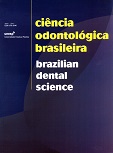The effect of filling techniques on compressive strength of dental composites
DOI:
https://doi.org/10.14295/bds.2005.v8i4.395Resumo
The aim of this study was to evaluated the effect of filling techniques on compressive strength of six dental composites. The composites (Z100, Surefil, P60, Definite, Prodigy Condensable, and Solitaire) were placed in circular aluminum molds with 2.5 mm in inner diameter and 5 mm in height. Each composite was divided into two groups (n=8): Group 1 – the composite was placed in the mold in bulk increment of 5 mm thick, covered with Mylar strip and photoactivated for 40 seconds; and, Group 2 – the composite was placed in two increments of 2.5 mm thick each and photoactivated for 40 seconds for each increment. Afterwards, the specimens were stored in a dark container, with distilled water at 37o C for 24 hours before test. After storage, the specimens were submitted to compressive strength in a Instron device at a crosshead speed of 1.0 mm/minute. Data were submitted to ANOVA and Test t – Student (5%) and showed that for each increment of condensable composite should not be greater than 2 – 3 mm and must be properly polymerized to get optimal mechanical properties. Z100 and P60 composites showed higher compressive strength values, while the lowest values were found for Prodigy and Solitaire.Downloads
Downloads
Publicado
Como Citar
Edição
Seção
Licença
TRANSFERÊNCIA DE DIREITOS AUTORAIS E DECLARAÇÃO DE RESPONSABILIDADE
Toda a propriedade de direitos autorais do artigo "____________________________________________________________________" é transferido do autor(es) para a CIÊNCIA ODONTOLÓGICA BRASILEIRA, no caso do trabalho ser publicado. O artigo não foi publicado em outro lugar e não foi submetido simultaneamente para publicação em outra revista.
Vimos por meio deste, atestar que trabalho é original e não apresenta dados manipulados, fraude ou plágio. Fizemos contribuição científica significativa para o estudo e estamos cientes dos dados apresentados e de acordo com a versão final do artigo. Assumimos total responsabilidade pelos aspectos éticos do estudo.
Este texto deve ser impresso e assinado por todos os autores. A versão digitalizada deverá ser apresentada como arquivo suplementar durante o processo de submissão.




























